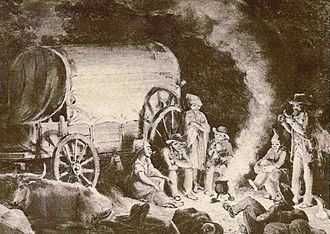Oorlam people

The Oorlam or Orlam people (also known as Orlaam, Oorlammers, Oerlams, or Orlamse Hottentots) are a subtribe of the Nama people, largely assimilated after their migration from the Cape Colony (today, part of South Africa) to Namaqualand and Damaraland (now in Namibia).
Oorlam clans were originally formed from mixed-race descendants of indigenous Khoikhoi, Europeans and slaves from Madagascar, India, and Indonesia. Similar to the other Afrikaans-speaking group at the time, the Trekboers, Oorlam originally populated the frontiers of the infant Cape Colony, later living as semi-nomadic commandos of mounted gunmen. Also like the Boers, they migrated inland from the Cape, and established several states in what is now modern South Africa and Namibia. The Oorlam migration in South Africa also produced the related Griqua people. [1]
Name
The origin of the name is disputed; at least a half-dozen versions can be found in the literature. It is said to be from the Malay expression orang lama (lit., "a man of long time"), meaning an old, experienced servant; from the Dutch word overlands or o'erlands, referring to those coming overland; from a disparaging Nama epithet meaning 'barren ewe'; from an Afrikaans word oorlam of unknown origin meaning 'sly' or 'cunning'; from a type of liquor sold in Cape Town; or from gorang, a Malay word for 'slave.' Finally, it has been suggested that the Orlams were named after one of the first European colonists who settled among them in their old homeland in the Cape Colony.[2]
History

When Oorlam communities migrated northward to Namaqualand from the Cape Colony beginning in the late eighteenth century, they occupied places earlier occupied by the Nama. They came partly to escape Dutch colonial conscription, partly to raid and trade, and partly to obtain herding lands.[3] Some of these emigrant Oorlams (including the band led by the outlaw Jager Afrikaner and his son Jonker Afrikaner in the Transgariep) retained links to Oorlam communities in or closer to the borders of the Cape Colony. In the face of gradual Boer expansion and then large scale Boer migrations away from British rule at the Cape, Jonker Afrikaner brought his people into Namaqualand by the mid-nineteenth century, becoming a formidable force for Oorlam domination over the Nama and against the Bantu-speaking Hereros for a period.[4]
Emerging from populations of Khoikhoi servants raised on Boer farms, many of them having been orphaned and captured in Dutch commando raids, Oorlams primarily spoke a version of Dutch or proto-Afrikaans and were much influenced by Cape Dutch colonial ways of life, including technological adoption of horses and guns, use of European-style clothing, and Christian worship.[5]
After two centuries of assimilation into the Nama culture, many Oorlams today regard Khoikhoigowab (Damara/Nama) as their mother tongue. The distinction between Namas and Oorlams has gradually disappeared, so that today they are regarded as a single ethnic group, despite their different origins.[6]
Clans
The Orlam people comprise various subtribes, clans, and families. In South Africa the Griqua are an influential Oorlam group.
The clans that migrated across the Oranje into South-West Africa are, in order of their time of arrival:
- The ǀAixaǀaen (Orlam Afrikaners), the first group to enter and permanently settle in Namibia. Their leader Klaas Afrikaner left the Cape Colony around 1770. The clan first built the fortress of ǁKhauxaǃnas, then moved to Blydeverwacht, and finally settled at Windhoek.[7]
- The ǃAman (Bethanie Orlam) subtribe settled at Bethanie at the turn of the eighteenth century.[8]
- The Kaiǀkhauan (Khauas Nama) subtribe formed in the 1830s, when the Vlermuis clan merged with the Amraal family.[8] Their home settlement became Naosanabis (now Leonardville), which they occupied from 1840 onward.[9] This clan ceased to exist after military defeat by Imperial German Schutztruppe in 1894 and 1896.[10]
- The ǀHaiǀkhauan (Berseba Orlam) subtribe formed in 1850, when the Tibot and Goliath families split from the ǃAman to found Berseba.[8]
- The ǀKhowesin (Witbooi Orlam) subtribe was the last to take up settlement in Namibia. They originated at Pella, south of the Orange River. Their home town became Gibeon.[8]
See also
- Oorlams creole
- Coloured
- Griqua people
- Basters
- Nama people
- Khoikhoi
Notes
- ↑ "Slavery in the Cape". Institute for the Study of Slavery and its Legacy – South Africa. Retrieved 8 July 2010.
- ↑ Alvin Kienetz, "The Key Role of the Orlam Migrations in the Early Europeanization of South-West Africa (Namibia)," The International Journal of African Historical Studies 10 (1977), p. 554, fn. 5, q.v. for sources of various theories.
- ↑ J. D. Omer-Cooper, History of Southern Africa (Portsmouth, NH: Heinemann, 1987), 263; Nigel Penn, "Drosters of the Bokkeveld and the Roggeveld, 1770–1800," in Slavery in South Africa: Captive Labor on the Dutch Frontier, ed. Elizabeth A. Eldredge and Fred Morton (Boulder, CO: Westview, 1994), 42; Martin Legassick, "The Northern Frontier to ca. 1840: The rise and decline of the Griqua people," in The Shaping of South African Society, 1652–1840, ed. Richard Elphick & Hermann Giliomee (Middletown, Connecticut: Wesleyan U. Press, 1988), 373–74.
- ↑ Omer-Cooper, 263-64.
- ↑ Legassick, 368-69; Penn, 42.
- ↑ Malan, Johan S (1998). Die Völker Namibias [The Tribes of Namibia] (in German). Windhoek, Göttingen: Klaus Hess. pp. 120–121.
- ↑ Dierks, Klaus. "Biographies of Namibian Personalities, A". Retrieved 24 June 2010.
- ↑ 8.0 8.1 8.2 8.3 Dedering, Tilman (1997). Hate the old and follow the new: Khoekhoe and missionaries in early nineteenth-century Namibia 2 (Missionsgeschichtliches Archiv ed.). Franz Steiner Verlag. pp. 59–61. ISBN 978-3-515-06872-7. Retrieved 7 February 2011.
- ↑ Dierks, Klaus. "Biographies of Namibian Personalities, L". Retrieved 14 January 2011.
- ↑ Shiremo, Shampapi (14 January 2011). "Captain Andreas Lambert: A brave warrior and a martyr of the Namibian anti-colonial resistance". New Era.
Further reading
- Kienetz, Alvin (1977). "The Key Role of the Orlam Migrations in the Early Europeanization of South-West Africa (Namibia)". The International Journal of African Historical Studies (Boston University African Studies Center) 10 (4): 553–572. ISSN 0361-7882. Retrieved 11 February 2013.
| ||||||||||||||||||||||||